
Elevated Toilet Seats
Features, Tips and Recommendations
Elevated toilet seats are great for improving safety and ease for the elderly when getting onto and off of the toilet.
For some reason, toilets are generally made quite low.
As with any surface, getting onto and off of a lower height is more difficult than when a surface is higher.
When you throw being elderly and having more trouble with strength and flexibility into the mix, then low toilets can be a real problem.
Elevated toilet seats simply raise the height of the toilet seat to make this easier.
They come in many shapes and sizes so it's important to choose one that will fit your toilet.
It is also important they are a good fit for your elderly loved one.
If elevated toilet seats are too low or high, they can actually not be helpful or even increase the risk of falls.
The article below gives you all the details you'll need to find the right elevated toilet seat for your elderly parent.
Who Should Use?
Elevated toilet seats are designed for anyone with decreased strength, endurance and balance. Seniors fit into this category. Installing a raised toilet seat is an excellent way to reduce the risk of falls!
Who Should NOT Use?
Elderly with extreme balance problems or who need an extremely sturdy surface might consider a commode with no wheels instead.
Recommended Features
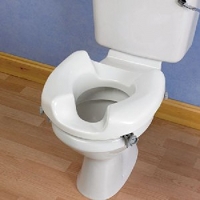
The most important feature of a raised toilet seat is that it fits your toilet properly!
The things to consider for fit are:
- Height: See "How to Fit" section for details of how to choose the proper height
- Shape: There are SO many different shaped toilets, you have to make sure your elevated toilet seat is the right shape for the toilet
- Closure Type: Some come with no closure (and this is ok on some toilets), others have a front securing mechanism or side tighteners to secure the elevated toilet seat on better
- Peri-area fit: One common complaint I hear about raised toilet seats is that the male genitals do not fit properly in some of the toilet seats. For more portly gentleman or those with difficulties with swollen prostate, consider a large sloped opening at the front of the elevated toilet seat.
- Cleaning: Consider which type would be easiest to clean
Warning: Raised Toilet Seats with Arms
I do not always recommend arms on raised toilet seats. If a person has poor strength and difficulty with balance, they sometimes will put too much weight on one of the arms and flip the elevated seat off. This, of course, is opposite to the point of an elevated toilet seat - which is to improve safety.
If you feel arms are needed but you're not sure your elderly loved one has the strength and balance to manage a raised toilet seat with arms, consider toilet safety rails or a commode over the toilet (with a sleeve rather than a bucket).
Accessories
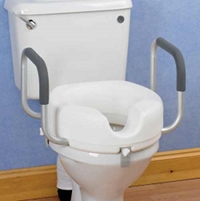
Raised seats come in many shapes and sizes (just like toilets):
- Different heights: 2", 3", 4"
- Different openings
- Some are built for petite elderly or women
- Some are built with men in mind with a larger sloped front opening
- Different style closures: front tighteners, side tighteners
- Different shapes: round, oblong, etc. to fit on different shaped toilets
- Padded
- Arms: some elevated seats come with arms, these are not always a safe feature
- Metal fastening system: some come with a metal fastening system on the bottom. These can be more cumbersome, difficult to fit and harder to clean
How to Fit
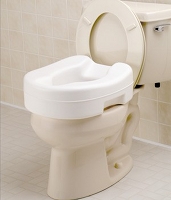
Make sure it will fit - it is surprising how many different designs of toilets there are. The only true way of knowing is through trial and error but keeping this in mind while shopping can help:
Seat Height:
Make sure the raised toilet seat doesn't make the total seat height too high (for all users). This is difficult if the users are significantly different heights such as 5 foot compared to 6 foot.
You want the top of the raised toilet seat to be at least to the crease of the users knee and not too tall that they cannot touch the floor when sitting down.
They come in different heights such as 2", 3", 3.5" and 4".
A good rule of thumb is to have them sit on a surface where their knees are just above 90 degrees with their feet flat on the floor.
Measure this height and then subtract the height of the toilet seat without the toilet seat cover. That is approximately the right height for your elderly parent's elevated seat.
How it Fastens:
Make sure elevated seats fasten securely. The last thing you want is a tipsy unstable elevated seat.
Some raised seats have no securing tighteners. These still work on some toilets for some people.
They are not suitable for people with very poor balance and a tendency to "plop" down when sitting as the seat will sometimes slide slightly in place and can cause a fall.
I prefer the designs that secure to the inside of the bowl rather than try to grip the outside of the bowl. They are more secure and have less tendency to loosen over time.
Weight Capacity:
Most elevated seats come with a weight capacity. Check it will properly support your loved one.
How to Use
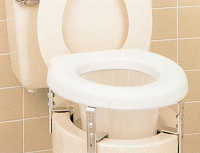
Once you have found the right fit and the elevated seat is secure, your elderly parent can start using it right away.
- They approach it like any sitting surface by backing up until they feel the toilet at the back of their legs.
- Then they take off their pants and sit down, trying to spread equal weight as they sit.
- Getting up is the same.
If extra support is needed, you can consider toilet safety rails or a bathroom grab bar beside the toilet to go with the elevated toilet seat. Or an alternative is a portable commode.
How Much Do They Cost?
Raised toilet seats cost anywhere between $35 and $150.
Return to Bathroom Products for the Elderly
Return to Equipment For Seniors
Return to Caring for Aging Parents


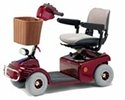



New! Comments
Have your say about what you just read! Leave me a comment in the box below.